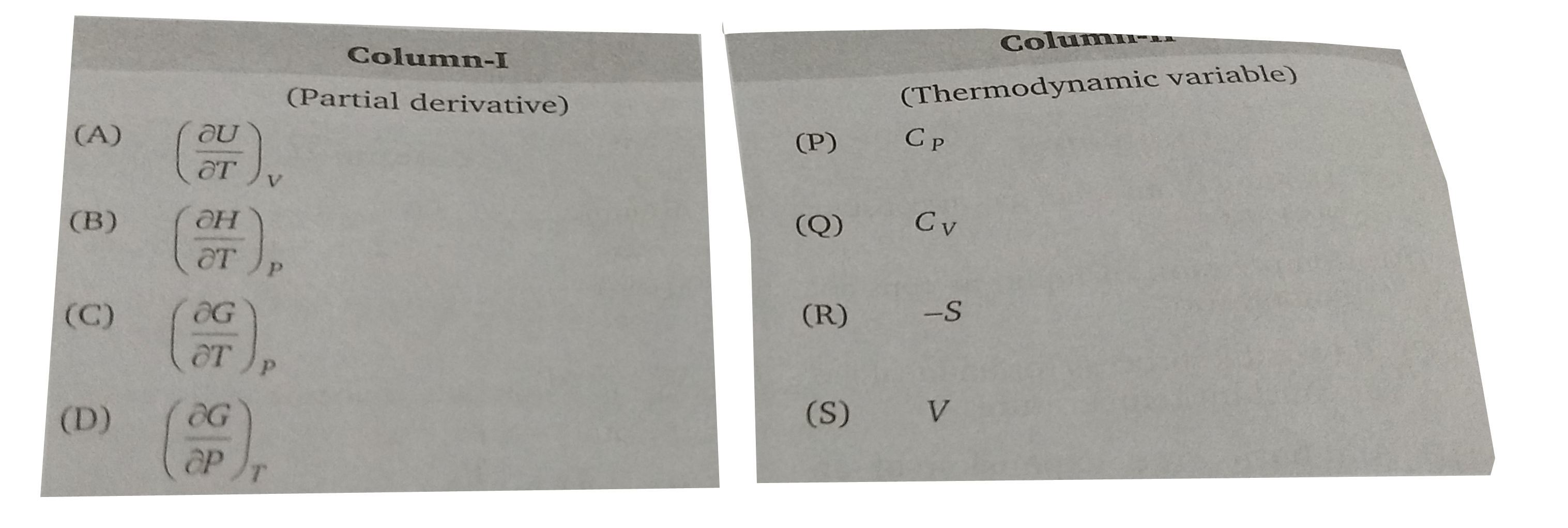For an ideal gas Cp,mCv,m=γ. The molecular mass of the gas is M, its specific heat capacity at constant volume is :Solution in Punjabi
RM(γ−1)
MR(γ−1)
γRMγ−1
γRM(γ−1)
The correct Answer is:A
∵Cp,mCV,m=γandCP,m−CV,m=R
∴CV,m=Rγ−1
CV,m=CVnandCV=m.cV
∴Rγ−1=m.cVm×M
∴ CV=R(γ−1)M
Topper's Solved these Questions
- BOOK - NARENDRA AWASTHICHAPTER - THERMODYNAMICSEXERCISE - Level 3 - One Or More Answers Are Correct1videos
THERMODYNAMICS
- BOOK - NARENDRA AWASTHICHAPTER - THERMODYNAMICSEXERCISE - Level 3 - Match The Column2videos
THERMODYNAMICS
- BOOK - NARENDRA AWASTHICHAPTER - THERMODYNAMICSEXERCISE - Level 2 (Q.1 To Q.30)1videos
THERMODYNAMICS
- BOOK - NARENDRA AWASTHICHAPTER - STOICHIOMETRYEXERCISE - Level 3 - Subjective Problems20videos
STOICHIOMETRY
Similar Questions
Assume ideal gas behaviour for all the gases considered and neglect vibrational degrees of freedom. Separate equimolar sample. Separate equimolar samples of Ne, O2 , CO2 and SO2 were subjected to a two process as mentioned. Initially all are at same state of temperature and pressue.
Step I → All undergo reversible adiabatic expansion to attain same final volume, which is double the original volume thereby causing the decreases in their temperature.
Step → After step I all are given appropriate amount of heat isochorically to restore the original temperature.
Mark the correct option(s) :01:40View SolutionMatch the following columns
 03:06View Solution
03:06View SolutionWrite structure of 2,2-dimethylheptane.
02:39View SolutionWhat volume of a liquid (in L) will contain 10 mole ? If molar mass of liquid is 280 and its density is 1.4 g/mL.
01:33View SolutionIf C_(p) and C_(v) denote the specific heats (per unit mass of an ideal gas of molecular weight M ), then where R is the molar gas constant.
04:11View SolutionFor an ideal gas (C_(p,m))/(C_(v,m))=gamma . The molecular mass of the gas is M, its specific heat capacity at constant volume is :
03:03View SolutionThe molar specific heat of an ideal gas at constant pressure and constant volume is C_(p) and C_(v) respectively. If R is the universal gas constant and the ratio of C_(p) to C_(v) is gamma , then C_(v) .
01:40View Solutionकिसी आदर्श गैस की विशिष्ट ऊष्मा धारिताएँ नियत दाब तथा आयतन पर क्रमशः CpतथाCv है। यदि γ=CpCv तथा सार्वत्रिक गैस नियतांक R हो तो Cv बराबर है -
02:06View SolutionIf the specific heat capacity and molecular mass ofa gas are c_(P) and M respectively then what will be the molar heat capaciity of the gas?
02:04View Solutionकिसी गैस की आण्विक विशिष्ट ऊष्मा धारिता को नियत आयतन तथा दाब पर क्रमश: Cv एवं Cp से दर्शाया जाता हैं तब
03:03View SolutionIf CpandCv denote the specific heats (per unit mass of an ideal gas of molecular weight M), then
where R is the molar gas constant.01:03View SolutionThe molecular weight of a gas is M. If the specific heat and molar specific heat at constant volume of the gas is cv and Cv respectively. Write down the relation between cv.Cv and M.
View SolutionFor an ideal gas Cp,mCv,m=γ. The molecular mass of the gas is M, its specific heat capacity at constant volume is :
02:34View Solutionनियत दाब पर M आण्विक भार की किसी गैस के लिए विशिष्ट ऊष्मा धारिता है- (γ=CPCV)
01:47View SolutionThe molar specific heat of an ideal gas at constant pressure and constant volume is C_(p) and C_(v) respectively. If R is the universal gas constant and the ratio of C_(p) to C_(v) is gamma , then C_(v) .
01:33View Solution

